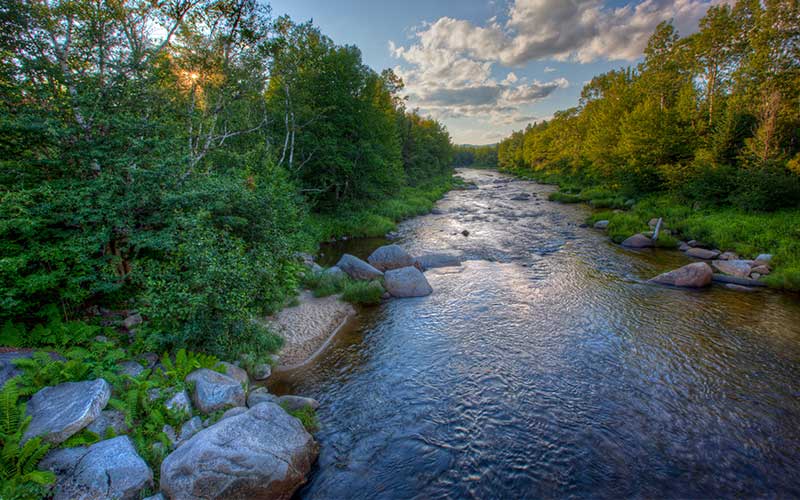
The Bethlehem landfill is putting the scenic Ammonoosuc River in danger. Photo: EcoPhotography
New Hampshire has a waste problem.
About two million tons of waste are burned or buried in New Hampshire each year. Unfortunately, around half of that waste is imported from outside of the Granite State, because the large landfills located in Rochester and Bethlehem accept waste from across New England.
But volume is only part of the problem. Landfills also pose a danger to the health of people and the environment. Reports show that both the Turnkey landfill in Rochester and the Bethlehem landfill are leaking contaminants into the local groundwater. Despite this, their owners/operators want to expand their respective landfills so they can accept even more garbage from other states.
We’ve already written about our efforts to stop the Turnkey landfill’s proposed expansion. Now we’re working with local residents in Bethlehem to help contain this dangerous facility before it can damage the environment even more.
Casella Waste Promises One Thing to the People of Bethlehem But Does Another
Bethlehem is a small North Country town – only about 2,500 people call it home – located at the northwest tip of the White Mountain National Forest. One of the area’s most spectacular waterways, the Ammonoosuc River, flows through its center. In a part of the state treasured for its natural beauty, a massive landfill seems like an anomaly. The idea of making that landfill even bigger has struck many locals as foolhardy in the extreme.
Knowing the owner of the landfill as well as we do, however, nothing surprises us. Casella Waste Systems, Inc., also operates what was Massachusetts’s largest landfill in Southbridge, where contamination of local wells caused such a public outcry that the company announced it would shut down the facility later this year.
Here in New Hampshire, Casella Waste made promises to Bethlehem town leaders that it would leave the landfill alone. A 2012 agreement with the Town stated that the company would not purchase property or expand the footprint of the facility past the approximately 50 acres currently permitted for landfilling.
So residents were understandably alarmed when Casella purchased 100 acres of land adjacent to the landfill a few years later. The company claimed the land wouldn’t be used to expand the facility but would be a source of sand and soil for landfill cover. Residents’ fears were confirmed when, last year, Casella put forward a series of town ballot questions to change the zoning of the newly purchased land and to authorize the town’s Board of Selectmen to negotiate with Casella to allow the landfill to expand onto it.
Residents defeated the ballot questions, but, undaunted, Casella pushed on. This month, the company tried again to use ballot questions to change the zoning of its parcel so it could expand the facility. Once again, residents resisted Casella’s agenda and defeated the questions at the local ballot.
But according to Casella, the company is not done yet. It is now pursuing “alternative expansion options,” which might mean trying to expand up instead of out by building new landfill cells on top of the existing site using earth walls (another trick they tried in Southbridge). Casella also bought another 80 acres of land recently for $500,000. Are they going to try and expand the landfill there? Only time will tell.
Stopping Expansion is Good; Now We Need to Stop Casella from Poisoning Our Waters
We applaud the residents of Bethlehem for saying no to expanding the landfill. But the town still has to contend with the contamination leaking from the site’s current footprint. In an effort to stem this toxic pollution, earlier this month, Toxics Action Center and CLF announced that we are suing Casella for illegally discharging pollution from the Bethlehem Landfill into the Ammonoosuc River.
Currently, contaminated groundwater and leachate (rain, snow, or other water in the landfill that has become contaminated with toxic substances in the buried waste) from the landfill are collecting in a seep on the site, then being discharged through a channel into the river without a permit. That is a clear violation of the Clean Water Act. The pollutants released include iron, manganese, and 1,4-dioxane (a probable carcinogen). We believe this discharge is harming the water quality of the Ammonoosuc River.
The Ammonoosuc supports a diverse array of aquatic life and is a popular destination for anglers, canoeists, kayakers, and more. We are not going to let Casella get away with draining pollution into this precious resource.
To Truly Solve New Hampshire’s Waste Problem, We Need to Produce Less Waste Overall
Casella’s illegal discharges into the Ammonoosuc are yet another sign that it’s time to stop expanding landfills and start reducing waste at its source through recycling and other efforts. It’s not just New Hampshire that has a waste problem, but all of New England. As a region, we produce almost 12 million tons of waste a year that ends up buried in a landfill or burned in an incinerator. CLF’s Zero Waste Project is working to raise awareness of how dangerous our waste disposal system is and promoting safer, more cost-effective, and more efficient alternatives.
Today, closing a landfill in one part of New England simply means that that waste becomes someone else’s toxic problem. While we must continue to protect our communities by holding landfills accountable for the harm they inflict on people and the environment, we must also take reduction, reuse, recycling, and composting seriously across the region. Only then can we solve our waste problem for good.



